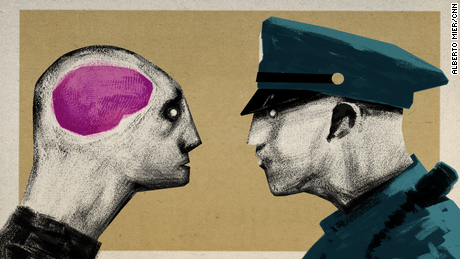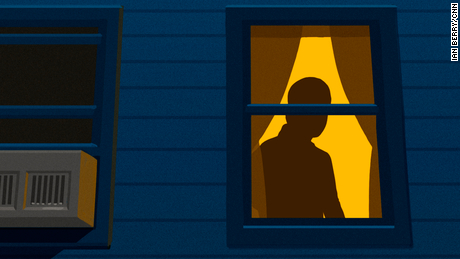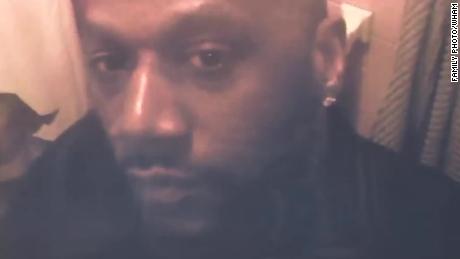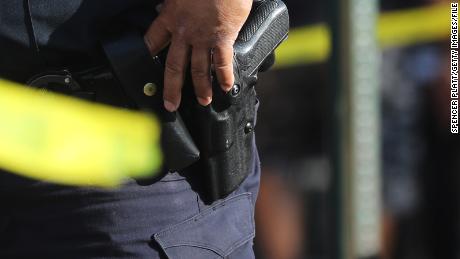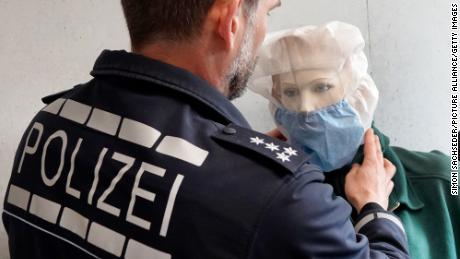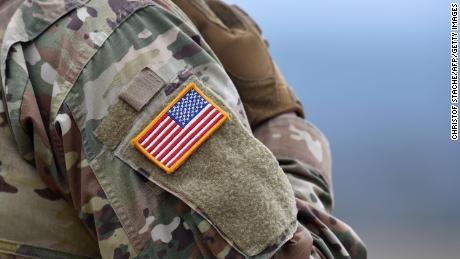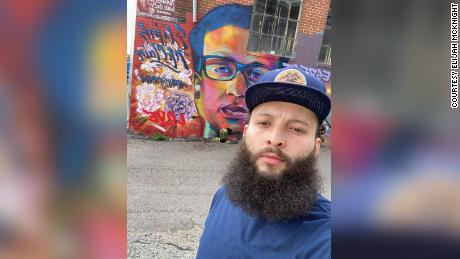These mental health crises ended in fatal police encounters. Now, some communities are trying a new approach
Updated 0905 GMT (1705 HKT) October 10, 2020
(CNN)When Miles Hall's hallucinations and erratic behavior returned, his mother did what she had always done: She gave police a heads up.
The next day, June 2, 2019, Walnut Creek, California, police responded to multiple 911 calls about Hall, 23, who was having a mental health episode and roaming around his neighborhood.
Five officers responded to the scene. Police say Hall was holding a pry bar -- a tool, his mother says, that a neighbor had given him for gardening -- and ran in their direction. After attempting to stop him with beanbag rounds, police fired at Hall. He died shortly after.
More than three months later, in a small Virginia community, Henrico County police responded to a welfare check requested by Gay Ellen Plack's psychiatrist. Plack, 57, was bipolar and "doing bizarre stuff," the psychiatrist said, and hadn't picked up her phone that day, according to a report by the Henrico County Commonwealth's Attorney.
Two officers went to Plack's home and she hid inside a bathroom in a locked bedroom. The officers breached the bedroom door and approached the bathroom and Plack came out with an axe -- a camping tool she had recently purchased, according to her brother. Within seconds, both officers fired. Plack was pronounced dead at a nearby hospital.
"I was just completely, completely shocked," her brother, Bob Bostock, says. "I couldn't believe that in her own home, she had been shot dead when she was minding her own business, not bothering anybody."
Hall and Plack belong to a list of Americans whose mental health breakdowns cost them their lives.
Last year, a former Georgia police officer was sentenced to serve 12 years in prison for killing a 26-year-old mentally ill Black veteran. In March, 41-year-old Daniel Prude was declared brain dead and died a week after his brother called Rochester, New York, police to report he was having a mental health episode. And four Houston officers were fired last month after the fatal shooting of an emotionally disturbed man who was on the ground and wounded.
While police departments have come under heightened scrutiny in recent months amid a racial reckoning stemming from fatal encounters with Black Americans, so have their actions in mental health emergencies. Experts and communities across the US are taking a hard look at whether law enforcement should be the first line of response.
"The short answer to that is no," says Shannon Scully, the senior manager of criminal justice policy at the National Alliance on Mental Illness (NAMI). "The law enforcement field is not equipped, nor should it ever be the first responder to a mental health crisis."
But with other mental health resources vastly underfunded -- or non-existent -- in many parts of the country, police departments have taken on the task by preparing patrol officers for these emergencies with the help of mental health training. Training which on its own, experts say, is not nearly enough.
'Smiles for Miles'
Growing up, Miles Hall was a "ball of energy," his mother says. He taught himself how to play piano and guitar. His freshman year of high school he was on the Honor Roll and played basketball. And he was always happy -- so happy, their neighborhood soon started calling him "Smiles."
"When you think of someone to be killed by the police, you don't think it's going to be someone who's so kind and gentle and has that reputation," Taun Hall says of her son. "I'd say Smiles for Miles, was definitely just like his nickname."
Miles Hall was diagnosed with schizoaffective disorder in his early 20s, his mother says. She says she opened a line of communication with police, not only to make sure they knew her son had episodes but also because he was an "African American in a white community." She told all their neighbors too.
On June 2, 2019, five 911 calls came in -- from both neighbors and family members -- about Miles Hall. His grandmother told a dispatcher he was "having a mental health breakdown," according to a video released by police. A neighbor called 911 next, mentioning "screaming and yelling" and an individual who had "psychiatric issues."
Taun Hall called 911 third, letting dispatchers know her son was holding a long pole and had broken a glass window at the home. "He has mental health issues," she told the dispatcher. "I called yesterday."
"He has to go," his mother added, and said the family had already left the house. When officers arrived in the neighborhood, they found Miles Hall on the street and began yelling his name. One officer fired bean bag rounds at him as Hall ran in their direction holding a large metal pole, as seen in the police video. When the bean bag rounds didn't stop Hall, two officers fired their handguns, according to a Walnut Creek police news release.
According to a lawsuit filed on behalf of Hall's family he was running in a "zig zagging manner" around the officers and not directly at them. In body camera video, Hall clearly puts distance between himself and the officers, running around them, when he is shot.
"I couldn't believe it," Taun Hall says. "I mean, I was like, 'They shot him, why would they shoot Miles? My baby is sick. Why would they use such extreme force?'"
Less than two weeks after the fatal shooting, Walnut Creek police announced the five officers involved were cleared to return to duty.
In their video, police said they had been involved in several other calls regarding Miles Hall. He had "no significant criminal history and the majority of these incidents were handled as mental health issues and not criminally prosecuted," Walnut Creek Police Lt. Tracie Reese said in the video.
Police said both the department and the county district attorney were investigating the shooting. A representative with the district attorney's office told CNN the investigation is ongoing and there's no firm date for when the report will be ready.
Last month, the city of Walnut Creek announced the $4 million settlement of a lawsuit with Hall's family, saying in a statement it hoped settling litigation will "provide a step towards healing." The settlement releases the city of "all current and potential claims against" them but does not admit any wrongdoing on behalf of the police.
Mental health responders on forefront
When officers respond to mental health crises, they should be trained to try and communicate with the person in crisis or nearby community and family members, says Seth Stoughton, a former law enforcement officer and associate professor of law at the University of South Carolina.
If that situation devolves into a dangerous one, officers use non-lethal options like Tasers and beanbags and if those fail and the person in crisis poses an imminent threat that's when officers fall back on lethal force, Stoughton says.
"The rules of lethal force do not differ just because someone is mentally ill,' he says. "The rules are still basically the same: when someone presents an imminent threat of death or great bodily harm."
But "very few" mental health calls actually involve violence, Stoughton says.
"Most of them are entirely capable of being resolved through non-violent means," he says.
In Walnut Creek, Taun Hall says her family wants to see a 24/7 non-police response to mental health crises. They've created the Miles Hall Foundation in efforts to help and equip other families faced with mental illness with the resources they need and continue pushing for mental health emergency reform.
During a city council meeting last month, Walnut Creek leaders said they have allocated $600,000 toward reform efforts, which include better training for police officers and city employees, along with a non-law enforcement program to address nonviolent crises.
That approach -- tapping police to respond only when they're needed -- is one that's been gaining traction across the country. Many turn to the Eugene, Oregon, CAHOOTS model for reference -- a decades-old program that dispatches unarmed responders to crises that aren't violent or criminal. The program said from the 24,000 calls it responded to in 2019, about 150 of them required police backup.
In Los Angeles, city leaders over the summer unanimously voted in favor of a measure that would develop an unarmed crisis response model, replacing officers with community-based responders for nonviolent calls. In other parts of California, volunteers teamed up to create MH First, a mental health response team available for emergencies several nights a month.
"Most cops don't want to be on the frontline of dealing with this problem either," Stoughton says. "They don't want to answer the mental health calls. They know very well that they don't have the training or the resources to do that."
But most often, there's no one else available around the clock to take the calls.
"Most places don't have that capacity. We don't have a staffed up agency of psychologists or mental health service providers, who can respond 24 hours a day, seven days a week, 365 days a year," Stoughton says.
A hybrid approach gets tested in Dallas
Some police departments maintain a law enforcement presence is still necessary in case crises turn volatile. Communities have experimented with adding both police and mental health specialists as the first line of response.
It's the kind of hybrid approach that's being tested out in one part of Dallas, where local authorities say the RIGHT Care program almost sounds like "the beginning of a bad joke."
"You've got a police officer, a paramedic and a social worker in a Tahoe for 16 hours," says Tami Kayea, the EMS Deputy Chief for Dallas Fire Rescue. The team is dispatched each time a 911 call involves a mental health component and the three members of the vehicle get to work in turns: Police secure the scene, paramedics rule out medical crises, and then a social worker evaluates the individuals involved and helps come up with a course of action.
The team has helped divert nearly 30% of its calls from jails and ERs and connected nearly 18% of people they've interacted with to mental health care, according to data from the Parkland Health & Hospital System.
"It's truly a social worker's scene but we want to make sure that they're safe," says Sgt. Jennifer Wells, with Dallas Police.
Those kinds of co-responder models, Scully says, are now increasingly used and can have "excellent results."
"But NAMI remains concerned about any model that inherently relies on law enforcement involvement in responses to mental health emergencies," Scully told CNN.
A SWAT team, only for mental health
In other parts of the country, it's often just patrol officers who show up -- and police departments have offered different types of training to prepare their staff for those emergencies.
In Rochester, where Prude died after a mental health episode, officers had received state-mandated training for "situations like these," Rochester Police Locust Club President Michael Mazzeo previously told CNN.
Other departments require every officer to undergo Crisis Intervention Team (CIT) training, usually a week-long course on how to navigate and de-escalate mental health emergencies. The training is just one component of what's known as the Memphis model -- the original CIT program created more than 30 years ago in efforts to rethink how officers should respond to people in mental health crises and divert those individuals from jails to mental health facilities.
"The tactics with CIT are low and slow," Stoughton says. "Officers keep things as calm as they can. They should not start shouting commands. They shouldn't aggress. They should maintain an appropriate distance, speak softly, listen, engage in very active communication."
In Walnut Creek, police receive at least 10 hours of annual training on how to respond to someone in a mental health crisis, Reese said. The department is working with neighboring agencies to create a CIT unit that would cover several jurisdictions, Walnut Creek Police Capt. Jay Hill said in a city council meeting last month.
In Henrico County, Virginia, where Gay Ellen Plack was fatally shot by police in her home, all officers in the police division take CIT training.
But a train-all approach isn't how the true CIT model is supposed to work, Scully says. Instead, she says, the CIT model is meant to offer a limited group of officers -- who would ideally volunteer for the job -- the ability to specialize in these situations through more extensive training and respond to mental health crises.
Think of these CIT officers as something like the SWAT team or the bomb squad.
"So what we have is officers who are self-selecting, officers who already maybe either care about these issues or who take these issues more seriously," said Stoughton, the policing expert. "Officers who didn't really want to be there, who don't really understand or want to understand the concepts, don't change what they're doing, right?"
And, in the fashion of the true CIT model, those specially trained officers would be just one part of a larger program that includes representatives from other agencies and parts of the community who work to tackle mental health response reform.
Responding officers knew Plack's history
Henrico County also has a CIT, made up of specially trained officers, behavioral specialists and other responders, that had interacted with Plack before and had handled her case "appropriately," said Bostock, Plack's brother.
But the team is most often not the first line of response for emergencies and instead works to check in and follow up on people who have mental health problems, according to Henrico Police Lt. Cindy Wood, who is a part of the county's CIT.
For emergencies requiring an immediate response, it's the closest patrol officers who respond. Henrico police say they respond to an average of about 2,800 mental health calls a year.
The two police officers who responded to the September 17, 2019, call for service heard from the dispatcher that Plack had a history of bipolar disorder and paranoia, according to the Commonwealth's Attorney report. They were made aware the residence had an attached "hazard message" -- used to alert authorities to proceed with caution -- and that Plack wouldn't let them in and would attempt to barricade herself in, the report says.
To Bostock, it was no surprise his sister hid inside a first-floor bathroom. After all, her previous encounters with police had often landed her in psychiatric units, her brother says, and she had quickly grown fearful of law enforcement.
One officer attempted to push the bathroom door open and noticed blood inside, according to the Commonwealth's Attorney report. He moved back quickly as Plack swung an axe. When the second officer moved toward the bathroom, Plack came out and "charged at" the officer, according to the report. The officer shouted several times for Plack to put down the axe before both officers fired. According to the report, one officer said he was fearful for his life.
Authorities showed body cam footage from the incident to local media and community leaders. After the shooting, an officer is heard saying, "Why did you do that? We were just trying to help you ma'am," according to CNN affiliate WWBT. That footage has not been publicly released.
Two months after the shooting, three Virginia Commonwealth's Attorneys concluded there was no criminal liability on the officers' part and no charges were filed. An internal affairs investigation also was conducted, police said, but those findings were not publicly released. Bostock says he's not considering a lawsuit at this time.
"I have always been a supporter of law enforcement," Bostock says. "I think they have a very hard job and all of that stuff."
"But in a case like this... what are they doing to make sure this doesn't happen again?"
If there are better ways to respond to mental health crises, including adding mental health personnel to the responding teams, Henrico County Police Lt. Col. Linda Toney says the department is "all on board for learning."
"I know that some people think it's the catch-all answer, but I can tell you that there's a lot of calls that mental health workers don't want to go on and that they want the gun there," Toney said. "I'm not saying that we would ever have to use the gun, but there's calls where they don't feel safe to respond."
"They don't have the same training, reaction time."
'We need to have the courage to experiment'
Plack, a mother of two, had spent time earlier in her life working as a nurse, Bostock says. She held art classes for people struggling with mental illness, taught Sunday School and tutored elementary school children once a week, he says.
"She was a 5-foot, 3-inch tall, 57-year-old woman in her own house, minding her own business and she ends up dead as a result of a welfare check," Bostock said. "She could not have been more innocent."
Police say Plack's call was handled appropriately.
"We do things very well on the front end," Lt. Wood says. "We are training our police officers and we're doing everything we need to do on the front end."
"On the back end, you've got to have somewhere for people to get the long-term care and the long-term hospitalization. And it's just not there at this point."
Eric English, the new Henrico Police Chief, has previously expressed strong support for mental health response reform.
"I've always said we should not be in the mental health field because any time we deal with mental health, we're bringing a gun, we're bringing a Taser ... and there's always the potential for something to go wrong," English said during a Harrisonburg city council meeting in June.
There's no simple answer to who should be the first line of response when there's a call for a mental health crisis. But the solution shouldn't focus on just more training for law enforcement, Scully says.
"The solution here is really looking at the mental health services and support centers in the community and then how law enforcement plays really kind of a secondary, supportive role," she says.
And there likely won't be a one-size-fits-all approach for every community.
"We don't know what the perfect response is yet," Stoughton says. "We need to have the courage to experiment a little bit and see what approaches really best serve the public interest."
